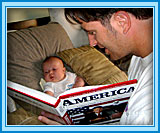
|
|
When parents read to older children they:
|
|
 |
Mainly read the text as is.
|
|
 |
Engage in some dialogue in response to child's questions about the
meaning of a word or something child wants to talk about. This conversation is important as a way to explore child's interests or feelings about a subject or an event that has taken place in your child's life. Sometimes a book will evoke strong feelings of sadness that brings you both to tears as when Charlotte dies near the end of Charlotte's Web. It is important that your child sees you respond so deeply to literature.
|
|
 |
Read with expression and dramatization to communicate meaning.
See section on "parentese".
|
|
 |
Sit next to child so book's illustrations can be seen. But if you read a chapter book with few or no illustrations, child only needs to hear your voice.
|
|
 |
Usually read book from beginning to end, unless you and your child don't like the book, and decide to switch to another.
|
|
 |
Allow child to select the book or offer a selection according to their child's interests.
|
|
When parents read to babies they:
|
|
 |
May or may not read all of the text of the book.
|
|
 |
 Mostly have a "dialogue" or "conversation" with their baby that may
or may not relate to book. "Dialogue" or "conversation" with babies means that baby responds to your talk by moving hands or feet, cooing, breathing faster, or giving you some bodily signal of response and pleasure. After you talk and read a little, allow your baby time to respond. Then you talk to your baby about responses. "You like that book because it's about that cute little duck like the one you have, etc." "Dialoguing" in this way feels natural. Trying to read the book straight through without responding to your baby feels unnatural. Try it both ways, and you'll see for yourself. The point is that you're teaching your baby the art of communication while giving him or her a constant stream of words, so necessary for language development. Mostly have a "dialogue" or "conversation" with their baby that may
or may not relate to book. "Dialogue" or "conversation" with babies means that baby responds to your talk by moving hands or feet, cooing, breathing faster, or giving you some bodily signal of response and pleasure. After you talk and read a little, allow your baby time to respond. Then you talk to your baby about responses. "You like that book because it's about that cute little duck like the one you have, etc." "Dialoguing" in this way feels natural. Trying to read the book straight through without responding to your baby feels unnatural. Try it both ways, and you'll see for yourself. The point is that you're teaching your baby the art of communication while giving him or her a constant stream of words, so necessary for language development.
|
|
 |
Use "parentese" to help babies hear sounds and rhythm of language.
|
|
 |
Allow baby to see parent's face as well as the book.
|
|
 |
Don't necessarily read book from beginning to end. Might even
change to another book in the middle of first book (especially true from a year to two year when baby starts moving about). As infants, babies can listen to whole book.
|
|
 |
Select books according to baby's language and physical development
Characteristics (see Six Baby Read-Aloud Stages from Birth to Two). After around eighteen months, toddlers may select books they want you to read.
|
|
